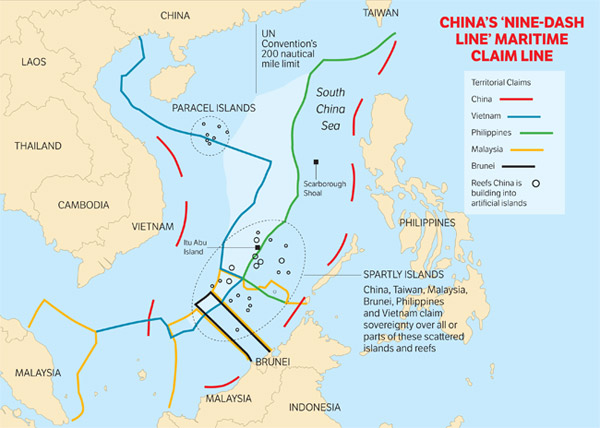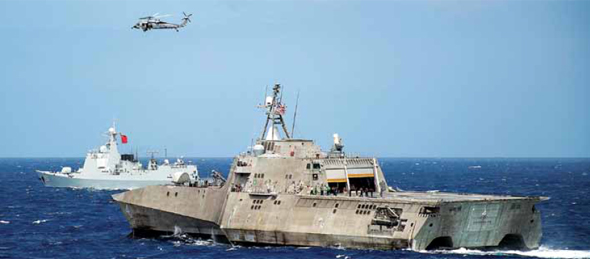INDIAN ARMED FORCES CHIEFS ON OUR RELENTLESS AND FOCUSED PUBLISHING EFFORTS

The insightful articles, inspiring narrations and analytical perspectives presented by the Editorial Team, establish an alluring connect with the reader. My compliments and best wishes to SP Guide Publications.

"Over the past 60 years, the growth of SP Guide Publications has mirrored the rising stature of Indian Navy. Its well-researched and informative magazines on Defence and Aerospace sector have served to shape an educated opinion of our military personnel, policy makers and the public alike. I wish SP's Publication team continued success, fair winds and following seas in all future endeavour!"

Since, its inception in 1964, SP Guide Publications has consistently demonstrated commitment to high-quality journalism in the aerospace and defence sectors, earning a well-deserved reputation as Asia's largest media house in this domain. I wish SP Guide Publications continued success in its pursuit of excellence.
- Operation Sindoor: Resolute yet Restrained
- India’s Operation Sindoor Sends a Clear Message to Terror and the World – ‘ZERO TOLERANCE’
- Japan and India set forth a defence cooperation consultancy framework, talks on tank and jet engines
- Terrorist Attack in Pahalgam in Kashmir: Unfolding a long surgical war against PAK
- Lt General Pratik Sharma takes over Command of Indian Army's Northern Command
Narrowing the seas: Security ramifications of the SCS verdict
 |
By Bharat Karnad Professor, National Security Studies, Centre for Policy Research |

There’s an aspect of China’s seeking to acquire dominance in the South China Sea that the verdict on July 11, 2016, by the International Court of Arbitration at the Hague, did nothing to address and, which difficult military problem, curiously, has not so far been identified in international and regional strategic circles, nor have solutions been bruited about. The problem concerns China’s narrowing this Sea by, quite literally, creating an obstacle course by forcibly annexing territory belonging to weak states, such as Philippines’ Scarborough Shoal in the Spratly Islands chain, and by creating ‘artificial’ islands. These are impediments designed to compel the navies of out-of-area powers and of the in-region disputant states, and, more generally, the $5 trillion worth of annual ship-borne trade transiting this area through select waterways that the Chinese can more effectively police. It will strategically disadvantage adversary navies, allow Beijing to exercise a whip hand over global and Asian trade, and, otherwise obtain a mere closum (closed sea) that countries will be able to access only at Beijing’s sufferance.
India has a burgeoning economic stake in the Vietnamese sea territory with the Indian energy major, ONGC Videsh, in 2014 formally joining PetroVietnam to exploit the energy resources in the Paracel Islands area claimed by China
This article briefly examines the security ramifications of this development and proposes certain countermeasures that India, in particular, and other like-minded states, such as Japan, need to take. The most potent solution, it will be argued, is to respond by counter-narrowing the same sea for China. India can do this, it will be contended, by arming ASEAN (Association of South East Asian Nations) members, starting with Vietnam, with the BrahMos supersonic cruise missile, which will tilt the ‘exchange ratio’ hugely against Chinese warships, and to militarily exploit factors, such as the distance of the disputed islands, rocky outcroppings, and the ‘artificial’ islands from the Chinese mainland against China, and skewing the advantage towards defender states.
Context
But to first set the context: The Hague Court not only rejected outright China’s expansive ‘Ninedash Line’ claims in the South China Sea but declared illegal its occupation of rocky protuberances that at high tide disappear under water. It also declared illegal the artificial ‘islands’ China has created by pouring cement on coral reefs in order to bolster its spurious claims, saying these do not endow Beijing with any exclusive economic zone rights and privileges, and condemned such manifestations of ‘land reclamation’ on seven features just in the Spratly Islands area alone, and chided China for such construction it said were “incompatible with the obligations on a state during dispute resolution proceedings”. Even if Beijing cannot claim the 12-mile exclusion zones around these newly built islands, it will feel free to consolidate its presence and use them for military purposes.
But the Tribunal did cut the ground from underneath Beijing’s historical basis for its claims. Chinese junks plying the disputed waters in the distant past, it ruled, cannot constitute a foundation for China’s extensive claims in the South China Sea, which the Court virtually dismissed as so much nonsense. “There was no legal basis”, it said unambiguously, for China’s “historic rights to resources within the sea areas falling within the ‘Nine-dash Line’. It is an injunction that will hereafter apply to Chinese claims landward as well, including large parts of Arunachal Pradesh and Aksai Chin in Ladakh.
While the Philippines, which took China to Court, called for “restraint and sobriety” in the wake of the verdict, and was supported by India, Japan, and the United States, who called on all parties to respect it, China, predictably, rejected it. Foreign Minister Wang Yi described it as a prescription for “a dose of the wrong medicine, which will not help cure the disease.” He went on to describe the malady as “fever” he accused external forces of “stirring up”. In any case, by imposing an air defence identification zone (ADIZ) and conducting live fire naval drills in the disputed sea conjoined to some severe diplomatic pressure, Beijing succeeded in having the 10-member ASEAN remove references to the dispute or the Hague verdict in the communiqué issued by the group’s 49th Foreign Ministers Meeting in Laos on July 20. China’s strong-arm tactics fit in with its preferred mode of negotiating separately and on bilateral basis with each of the disputant states, something that Beijing believes will render them more amenable. But most legal experts agree that even if the regional states end up dealing singly, one-on-one, with China they will hereon insist on the new legal template established by the Hague Court.
That regional countries are loath to cross China is understandable. They have profited from balancing economic cooperation with China and US’ security assurances. In the weeks prior to the Hague ruling, three US missile destroyers and the nearby USS Ronald Reagan Carrier Strike Group, had taken to ‘stalking’ the artificial islands, such as those near the Scarborough Shoal the Chinese had forcefully annexed from the Philippines in 2013. These ships operated in the 14-20 nautical mile range of these islands ostensibly on freedom of navigation patrols (FONPs) permitted by the 1982 UN Convention on the Law of the Seas (UNCLOS). The US will continue with such operations in the future to assert its rights. And more frequent FONPs is also what New Delhi should dispatch to these waters to assert India’s right of free and peaceable passage.
Except the United States has not ratified this Convention, and neither has China, even as the ASEAN have done so, as have India in June 1995 and Japan a year later. Hence, such naval and air actions as the US may undertake against Chinese forces under the 2014 Enhanced Defence Cooperation Agreement (EDCA) with Manila, which revives in a way the 1951 Mutual Defence Treaty that became defunct in 1992 with Philippines refusing to extend it could, theoretically, come under a legal cloud, unless the US warships fly the Philippine flag providing Manila and Washington the cover of self-defence, which last will not happen.
Chinese Buildup and US Response
Speed of buildup being of the essence, China, according to satellite intelligence, had by February 2016, erected a high frequency radar on Cuarteron Island able to monitor on real time, 24x7, basis the air and surface traffic in the southern part of the South China Sea, i.e., the northern end of the Malacca Strait. It augmented the radars already on Fiery Cross, Gaven, Hughes and Johnson South Reefs in the Spratly’s chain, with helipads, and possible gun and missile emplacement’s too at some of these posts. Mapping the Chinese land reclamations in the South China Sea indicates a pattern. These are mostly grouped in the spread of the Spratly Islands right smack in the middle of the South China Sea—a quadrant that opens out to the East Sea in the northeast and the Malacca, Lumbok and Sunda Straits to the south-west encompassing most of the main oceanic trade-carrying highways.
To deter US carrier task forces from entering these disputed area, Beijing has deployed the Dong Feng DF-21D anti-ship ballistic missile system along with Hong H-K6 medium bombers (Chinese variant of the Soviet Tu-15) on the islands it has illegally occupied or constructed. The logic obviously is that if the US Navy can be made less confident in these waters, the other countries will offer no resistance at all. These artificial and natural islands bristling with radar/other sensors and weapons systems will constrict the passage ways, and all maritime traffic, including naval movements, through these waters will be subject to Chinese surveillance and effectively pass under Beijing’s control.

While Washington says it will contest what the US Pacific Fleet commander Admiral Scott Swift said at an October 2015 conference in Sydney, is an ‘egregious’ tendency of countries, like China, to “view freedom of the seas as up for grabs, as something that can be taken down and redefined by domestic law or by reinterpreting international law” and to impose “superfluous warnings and restrictions on freedom of the seas in their exclusive economic zones and claim territorial water rights that are inconsistent with [UNCLOS]”, the US is unlikely to come to any ASEAN partner’s aid, EDCA or no EDCA, if this interferes or diverts from the larger US aim of reaching a modus vivendi with Beijing. The US Naval Chief, Admiral John Richardson, made this plain. “Cooperation [with China] would be great”, he said at a Center for New American Security conference held in Washington in June 2016, “competition is fine [but] conflict is the thing that we really want to avoid.” He was reflecting the views of President Barack Obama, who in early 2016 negatived a muscular approach proposed by the head of the US Pacific Command, Admiral Harry Harris, per a news report, to “counter and reverse China’s strategic gains” in this region.
What India Can and Should Do
Washington’s willingness to compromise with China, and Beijing’s desire to prevent militarily riling up America means these two countries will eventually work out a mutually acceptable solution that may not constitute rules-of-the-road for anybody else, or help the ASEAN disputants bolster their individual claims with respect to China. This is the main reason why it is in New Delhi’s interest to be proactive and to coordinate its policies to beef up the dissuasive military capabilities of the ASEAN states with those of, say, Japan. India and Japan cannot anymore afford to fallback on their default position of free riding on America’s security coattails in the hope their interests will be served, or to identify with the US military activity in the South China Sea not aimed at constraining China’s freedom of action.
Which are the littoral and offshore states that have shown the most grit in opposing Beijing? These are Vietnam and Taiwan, followed by Indonesia and Malaysia. Except, Taiwan for political reasons claims exactly the same Nine dash-Line space as China, and will not array itself against Beijing in this dispute. Empowering Vietnam is the best bet and could have a telling demonstration effect. India has a burgeoning economic stake in the Vietnamese sea territory with the Indian energy major, ONGC Videsh, in 2014 formally joining PetroVietnam to exploit the energy resources in Blocks 102/10 and 106/10 in the Paracel Islands area claimed by China, where it has 40 per cent and 50 per cent share respectively. Assets, such as giant rigs and the underway oil/gas exploration and drilling activity will have to be protected against adversarial actions in what Beijing calls “China administered waters”.
India and Japan cannot anymore afford to fallback on their default position of free riding on America’s security coattails in the hope their interests will be served
The strategic gains from arming Vietnam with specially devastating armaments having finally dawned on the Indian Government, New Delhi agreed to sell/transfer to Hanoi the indefensible BrahMos supersonic cruise missile. Operationally deployed in coastal batteries and on Vietnamese warships and submarines, the BrahMos will have a chilling effect on the Chinese Navy’s secret ‘Fourth Fleet’ tasked for the Indian Ocean and co-located with the South Sea Fleet on the Sanya naval base on Hainan Island. It could lead to Philippines, Indonesia, and Malaysia seeking similar armaments. With all these countries so armed, the same sea will be effectively narrowed and rendered equally dangerous for Chinese merchantmen and naval ships acting belligerently. When a cruise missile costing Rs. 10 crore can take out a destroyer costing Rs. 7,000 crore, Chinese commanders will soon face a huge operational dilemma. It will immediately inhibit Chinese commanders from casually ordering their vessels on provocative missions and combatant ship captains from courting risk. In this respect, China will also discover that the relatively long distance from the mainland to the disputed area can become a liability in terms of sustaining offensive naval or other military action. Scarborough Shoal, only 230 km west eastern most island of the Philippines, is some 990 km from the Chinese coast.
Thus, BrahMos versus Chinese warships, militarily exploiting the distance-differential from home areas, etc. are the sorts of asymmetries that countries within and without the South China Sea region need urgently to exacerbate. It is the only way to prevent China dominating the South China Sea.
Bharat Karnad is Professor in National Security Studies at the Centre for Policy Research. He is author of most recently published book Why India is Not a Great Power (Yet), and blogs at www.bharatkarnad.com.





